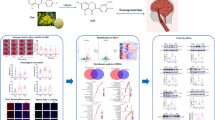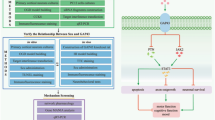Abstract
Neonatal hypoxic-ischemic (HI) encephalopathy can lead to severe brain damage, and is a common cause of neurological handicaps in adulthood. HI can be resolved by the administration of an antioxidant such as 3-methyl-1-phenyl-2-pyrazolin-5-one (MCI-186). In the present study, we performed comprehensive gene expression and gene network analyses using a DNA microarray to elucidate the molecular events responsible for the selective vulnerability of neurons in neonatal HI brain insult and to examine the underlying mechanisms of the effect of MCI-186 on the pathophysiological events in this condition. We used the modified Levine method (Rice model), which has been widely used as an animal model of this condition. A large difference in gene expression was observed between the Rice model and the control group. Up- and downregulated genes after the HI brain insult were mainly related to immune responses and cell death, and neuronal activity, respectively. The effect of MCI-186 administration on gene expression was much less than and contrary to that of the HI brain insult, reflecting the protective effect of MCI-186 in HI brain insult.




Similar content being viewed by others
References
Banno T, Gazel A, Blumenberg M (2004) Effects of tumor necrosis factor-α (TNFα) in epidermal keratinocytes revealed using global transcriptional profiling. J Biol Chem 279:32633–32642
Bronte V, Apolloni E, Cabrelle A, Ronca R, Serafini P, Zamboni P, Restifo NP, Zanovello P (2000) Identification of a CD11b+/Gr-1+/CD31+myeloid progenitor capable of activating or suppressing CD8 + T cells. Blood 96:3838–3846
Hedtjarn M, Mallard C, Eklind S, Gustafson-Brywe K, Hagberg H (2004) Global gene expression in the immature brain after hypoxia-ischemia. J Cereb Blood Flow Metab 24:1317–1332
Ikeda T, Xia YX, Kaneko M, Sameshima H, Ikenoue T (2002) Effect of the free radical scavenger, 3-methyl-1-phenyl-2-pyrazolin-5-one (MCI-186), on hypoxia-ischemia-induced brain injury in neonatal rats. Neurosci Lett 329:33–36
Johnston MV, Nakajima W, Hagberg H (2002) Mechanisms of hypoxic neurodegeneration in the developing brain. The Neuroscientist 8:212–220
Juul SE, Beyer RP, Bammler TK, Mcpherson RJ, Wilkerson JASM, Farin FM (2009) Microarray analysis of high-dose recombinant erythropoietin treatment of unilateral brain injury in neonatal mouse hippocampus. Pediatr Res 65:485–492
Klippel S, Strunck E, Roder S, Lubbert M, Lange W, Azemar M, Meinhardt G, Schaefer HE, Pahl HL (2000) Cloning of PRV-1, a novel member of the uPAR receptor superfamily, which is overexpressed in polycythemia rubra vera. Blood 95:2569–2576
Levine S (1960) Anoxic-ischemic encephalopathy in rats. Am J Pathol 36:1–17
Matsuzaki H, Kobayashi H, Yagyu T, Wakahara K, Kondo T, Kurita N, Sekino H, Inagaki K, Suzuki M, Kanayama N, Terao T (2004) Bikunin inhibits lipopolysaccharide-induced tumor necrosis factor alpha induction in macrophages. Clin Vaccine Immunol 11:1140–1147
Nakajima W, Ishida A, Lange MS, Gabrielson KL, Wilson MA, Martin LJ, Blue ME, Johnston MV (2000) Apoptosis has a prolonged role in the neurodegeneration after hypoxic ischemia in the newborn rat. J Neurosci 20:7994–8004
Noor JI, Ikeda T, Mishima K, Aoo N, Ohta S, Egashira N, Iwasaki K, Fujiwara M, Ikenoue T (2005a) Short-term administration of a new free radical scavenger, edaravone, is more effective than its long-term administration for the treatment of neonatal hypoxic-ischemic encephalopathy. Stroke 36:2468–2474
Noor JI, Ikeda T, Ueda Y, Ikenoue T (2005b) A free radical scavenger, edaravone, inhibits lipid peroxidation and the production of nitric oxide in hypoxic-ischemic brain damage of neonatal rats. Am J Obstet Gynecol 193:1703–1708
Ota A, Ikeda T, Ikenoue T, Toshimori K (1997) Sequence of neuronal responses assessed by immunohistochemistry in the newborn rat brain after hypoxia-ischemia. Am J Obstet Gynecol 177:519–526
Resch ZT, Chen BK, Bale LK, Oxvig C, Overgaard MT, Conover CA (2004) Pregnancy-associated plasma protein a gene expression as a target of inflammatory cytokines. Endocrinology 145:1124–1129
Rice JE, Robert CV, James BB (1981) The influence of immaturity on hypoxic-ischemic brain damage in the rat. Ann Neurol 9:131–141
Robertson CM, Finer NN (1993) Long-term follow-up of term neonates with perinatal asphyxia. Clin Perinatol 20:483–500
Sharma S, Stolina M, Zhu L, Lin Y, Batra R, Huang M, Strieter R, Dubinett SM (2001) Secondary lymphoid organ chemokine reduces pulmonary tumor burden in spontaneous murine bronchoalveolar cell carcinoma. Cancer Res 61:6406–6412
Ueda Y, Noor J, Nagatomo K, Doi T, Ikeda T, Nakajima A, Ikenoue T (2006) Generation of lipid radicals in the hippocampus of neonatal rats after acute hypoxic-ischemic brain damage. Exp Brain Res 169:117–121
Yasuoka N, Nakajima W, Ishida A, Takada G (2004) Neuroprotection of edaravone on hypoxic-ischemic brain injury in neonatal rats. Dev Brain Res 151:129–139
Acknowledgments
We are grateful to Dr. Mutsumi Kanamori (RIKEN OSC) for her technical advice and thank Ms. Ritsuko Ozawa for the technical assistance. This work was supported by a grant from the Core Research for Evolutionary Science and Technology (CREST) program of the Japan Science and Technology Agency (JST) and an in-house budget of RIKEN.
Author information
Authors and Affiliations
Corresponding author
Electronic Supplementary Materials
Below is the link to the electronic supplementary material.
Supplementary Table S1
RICE cluster0 genes (XLS 64 kb)
Supplementary Table S2
RICE cluster1 genes (XLS 146 kb)
Supplementary Table S3
RICE cluster2 genes (XLS 62 kb)
Supplementary Table S4
MCI-186 upregulated genes (XLS 21 kb)
Supplementary Table S5
MCI-186 downregulated genes (XLS 16 kb)
Rights and permissions
About this article
Cite this article
Kojima, T., Ueda, Y., Adati, N. et al. Gene Network Analysis to Determine the Effects of Antioxidant Treatment in a Rat Model of Neonatal Hypoxic-Ischemic Encephalopathy. J Mol Neurosci 42, 154–161 (2010). https://doi.org/10.1007/s12031-010-9337-x
Received:
Accepted:
Published:
Issue Date:
DOI: https://doi.org/10.1007/s12031-010-9337-x




